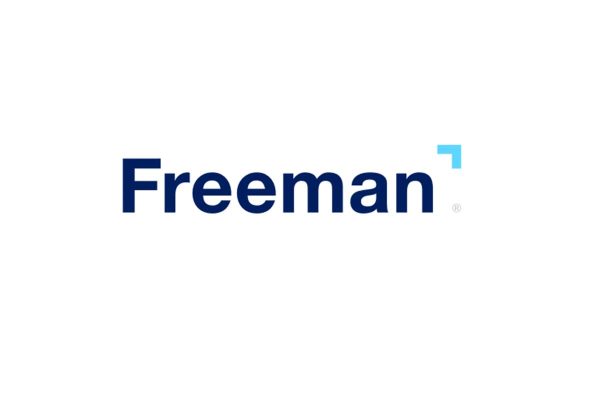(Pictured above: Designed by Synthesis Design + Architecture)
by Allison Pocewicz, marketing coordinator, Fabric Images, Inc.
The tradeshow floor has seen its fair share of trends over the years. The market has continuously morphed to accommodate the latest developments in materials and technology that will speak to an evolving demographic of attendees. Advancements have taken place so rapidly that it is easy to lose sight of the strides made in years past. Take, for example, fabric architecture—25 years ago this solution for tradeshow environments was barely a thought. Jump ahead to current day and you can’t turn a corner without experiencing fabric.
The journey of fabric within the tradeshow industry took the dedication and drive of pioneering companies, one of whom is Fabric Images, Inc. For the past 25 years Fabric Images, Inc., has been dedicated to advancing the integration of fabric based architecture within environments to enrich brand identity and attendee experience. This passion to lead and impact the industry in the realm of printed and non-printed tension fabric architecture has introduced the following:
- In 1996, Fabric Images, Inc., became the first company to offer printing, sewing and metal fabrication under one roof.
- In 1999, Fabric Images began promoting the environmental attributes of fabric architecture, including education in modular and re-usable design and recycling.
- 2001 brought the introduction of Superwide, 10ft. wide dye sublimation printing on textiles, a technology that Fabric Images, Inc., fought to develop and was the first in the world to launch.
- In 2004, Fabric Images, Inc., showcased a fully immersive, entirely self-supported, fabric experience, bridging design with the personality of textiles.(see image 1)
- In 2009, Fabric Images, Inc. introduced the FreeStyle custom rental program.
- 2010 launched 15 foot seamless dye sublimation printing
- In 2013, Fabric Images, Inc., successfully completed the fabrication of the Volvo PURE Tension Pavilion, a tension fabric structure with solar power integration.(see image 2)
- In 2014, Fabric Images, Inc., launched the ReLife Recycling program, a complementary recycling program extended to customers promoting the recycling of out-of-use frames and polyester fabric skins.
In 25 years, tension fabric has gone from being an infant in development to a commodity within the exhibit industry. It has been shaped by a generation. And now that it has been shaped, to the future generations it is the norm. As an industry we are on the verge of a generational cross-over that will be highly significant to the industry. Those who shaped and nurtured the last 25 years will begin seeing influences from the younger generations; Generations who value experience over accumulation, crave sustainability and who will continue to push the limits as well as develop new materials and technologies, making today’s norm part of our history. While fabric is a staple in our industry, we have barely scratched the surface of what can be achieved. When looking at the role of textiles and fabric architecture in design in the next 25 years, we first need to understand the influencers.
There is a Rising Need for Experience
There is a shift taking place in how consumers see and interact with brands, from physical spaces to digital presence. Beginning with the millennial generation, digital has become a norm, so brands are now expanding their efforts beyond digital to create memorable experiences that will connect with the audience, not only digitally, but within physical spaces as well. In retail, for example, new models are forming where we are being introduced to showrooms and lifestyle experiences. Brands and stores are creating environments, not simply for shopping, but for experiencing, interacting and engaging.
Next, consider the changing dynamics in hospitality. As the arts of describing, showing or performing that represent the traditions or the way of life of a particular people or group; literature, art, music, dance, theater, etc., new generations of travelers demand authenticity, and as we venture over to an economy focused on experience, hoteliers are redefining hotel environments. Where hotel design is trending is toward a lifestyle promise and a broad cultural experience. Hoteliers are changing layouts while creating culturally vibrant experiences and escapism for guests. Much more attention is being paid to the design and details within the environment.
Why is this important for us to understand? The design of a space goes beyond what it looks like, to the feeling it creates and how it engages and connects with the attendee. Recent studies show that the average attention span has decreased to eight seconds. That is four seconds fewer than 15 years ago and less than that of a gold fish! This is especially prominent with Generation Z (born mid-late ‘90s), our future attendees. The design of branded spaces in the future will rely on smarter solutions to counteract a limited attention span and an overload of technology. This is where fabric comes in.
An Evolution for Fabric Technology
We hear a lot about the advances in technology as it relates to digital, which has led to a fast-paced digital transformation. But, what we are missing out on is the transformation of textiles and what that will do for the industry. There are two directions to the future regarding textiles. One is the technological advancements, and the other is the experiential incorporation.
Textile advancement already includes nanotechnology. This has allowed the properties of textiles to be altered to include entirely new properties and functions, including traits such as water repellence, wrinkle resistance, strength enhancement, and antibacterial and antimicrobial abilities. In addition, color changing, or “photonic” technology allows textiles to change color based on ambient heat, while optical technology in fabric is altering the appearance by controlling the intensity, color, and pattern of light. While these traits are physical ones which may enhance the abilities and usage within tension fabric solutions and environments, an evolution is happening that will push the limits of what textiles can do in the future.
According to the article “Nanotechnology in Textiles – the new Black” (http://www.nanowerk.com/spotlight/spotid=42713.php), in the future we can expect to see textiles further embrace technology through characteristics such as,
- Energy saving fabrics that can lead to “smart” solutions which can power integrated electronics and sensors through movement.
- Interwoven solar cells
- Textile batteries that can be recharged by sunlight
- Nanoelectronics at the tip of a gloved finger
- Graphene yarns that facilitate energy storage in textiles
While we have seen digital and augmented reality change the brand conversation, the advancements taking place in textiles will begin to redirect attendee attention to surfaces that are unexpected, smarter and multi-sensory.
The Experiential Component of Fabric
While textile technology is advancing, there is a pure appeal to fabric that involves multi-sensory characteristics. Consider the saying “touching materials visually”. With the average attention span at only eight seconds, the more senses that are engaged within the brand story, the faster and deeper the brand connection will form. Today’s exhibit landscape is graphically heavy, but very flat, limiting sensory engagement. The expectation for storytelling to marketing and brand environments of the future demands the integration of unique, multi-sensory materials and applications.
Textiles have a distinctive ability to connect on multiple levels and can take the most stimulated sense of sight and trigger other senses, like that of touch. Although this can sometimes be achieved with a creative use of graphics, texture and visually unique textile surfaces can offer a surprising and memorable experience. Beyond the few common fabrics most utilized within the industry, is a vault consisting of thousands of textiles. If this sounds overwhelming, simply remember that only a handful of fabrics speak to an individual brand. And the message offered is experiential value.
The tactile value of fabric also crosses over to the complexity of form. The form is the structure which holds the fabric and is every bit as important to the experience as the covering. It acts as the base to the brand’s visual language and culture. As we move into the future, creating complex forms will become easier to design, easier to produce, and more cost effective as a result of advancements that are being made in software and manufacturing implementation. For example, a fluid brand will no longer have to succumb to a flat form due to budget restraints, keeping the brand image intact. The combination of form and tactile sensation will represent brand value, brand personality and will offer an immersive storytelling experience when accurately conveyed within a brand environment.

What does the future hold?
Twenty five years ago the market was saturated with wood. Today, with fabric in the forefront, it is heavy with systems and simplicity. With generational shifts and experience-heavy expectations, design of tomorrow will push the limits in branded spaces, placing focus on the expression of brand and culture. It is time to prepare for further advancement and better integration of the use of textiles and tension fabric structures within environments to accommodate to the upcoming generations of brands and attendees on the show floor. The future is affording us the opportunity to create an emotionally charged outlet for brand engagement, which is crucial to brand connection and storytelling success. While the past 25 years has shaped the industry, in the next 25 there will continue to be an evolution of textiles and tension fabric structures within environments.
This column originally appeared in the November/December 2017 issue of Exhibit City News magazine, p. 32. For more pictures and original layout, visit https://issuu.com/exhibitcitynews/docs/novcdec2017_ecn_flipbook






























